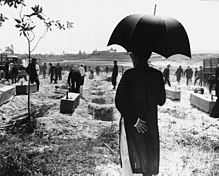Massacre at Huế
An expert on the subject should have a look at this article or section. |
| Masscare at Huế | |
|---|---|
| Part of Vietnam War, Tết Offensive | |
 300 unidentified victims of the massacre are being buried, in 1968 | |
| Native name | Thảm sát ở Huế |
| Location | |
| Date | February 28, 1968 |
| Target | Men, Women, Children, Baby |
| Deaths | 11,576 |
| Perpetrators | |
| Defenders | |
| Motive | Huế people supported Capitalism |
Masscare at Huế, is a mass murder and execution perpetrated by Viet Cong and the Liberation Army during the Democratic Republic of Vietnam control territory of Huế. V.C and North Vietnam killed people because they were supported South Vietnam and the United States Army.
The Liberation Army counter-attacked the United States Army in Huế, bombing the city, killing many civilians, and burying the civilians. that population, along with the dead soldiers of all warring parties. Finally, many sources from the Democratic Republic of Vietnam confirmed that there was no such thing as a "bloody massacre" in Huế.[1]
Background[change | change source]
In the early morning of January 31, 1968, during the Lunar New Year, the People's Army of Vietnam and the Liberation Army of South Vietnam simultaneously launched a surprise attack in many cities and localities in South Vietnam - in the early morning of January 31, 1968. including Saigon and Huế. After initial military successes, they were overwhelmed by the enemy and pushed back everywhere, except Huế. Although the Tet Offensive was considered a tactical defeat, it was a victory of great strategic importance.
With the aim of seizing sovereignty over Huế, a 28-day battle between the South Vietnamese Liberation Army and the US Army and the Army of the Republic of Vietnam took place and resulted in 40% of the city being destroyed, 116,000 homeless people. The US Army and the Army of the Republic of Vietnam suffered about 4,400 casualties, while the South Vietnamese Liberation Army and the Vietnam People's Army also lost over 4,000 troops. Also in this re-occupation, the US army used maximum heavy weapons such as napalm bombs, cannons, tank cannons and large recoilless guns . Out of 17,134 houses in Huế, 9,776 houses were completely destroyed, 3,169 were severely damaged; The number of civilians killed according to the first estimate of the government of the Republic of Vietnam was 3,776. The South Vietnamese Liberation Army documents said they buried about 2,000 bomb victims in mass graves along with their own dead soldiers.[2][3]
Aftermath[change | change source]
In the months and years that followed the Battle of Mau Than at Hue, which began on January 31, 1968, and lasted a total of 26 days, dozens of mass graves were discovered in and around Huế. Victims include women, men, children and baby.[4]
According to Gareth Porter,[5] an American scholar, early estimates by the Ministry of Immigration and Social Security of the Republic of Vietnam put the number of civilians killed by fighting and artillery fire at 3,776, out of the total number of civilians. wounded, dead or missing were 6,700 people.[6] Italian journalist Oriana Fallaci in her autographs said that about 1,100 people were killed when the North Vietnamese troops recaptured Huế, most of the people killed were teachers, lectures, university students, monks, intellectuals and religion followers (mostly buddhist). Historian Stanley Karnow believes that many civilians were executed by the North Vietnamese and their bodies were buried in mass graves.[7]
According to Lê Minh, the commander of the campaign for the whole Thừa Thiên Huế area, the Secretary of the Hue City Party Committee during the Tết Offensive, wrote in his memoirs published in 1988, most civilians died due to being hit by American bombs. city, only a small number were killed as civilians rebelled against those they hated.[8][9]
A Vietnamese witness in Huế, Nguyễn Thị Hoa, said: "It started with them (US troops) using artillery. They bombarded the area where we lived, razed houses and trees. They fired artillery at the houses in the surrounding areas. These houses sold gasoline, so when the firecrackers were fired, they burned down. All the elderly, children, and women who took refuge here were burned alive."[10]
Don Oberdorfer also cited several sources reporting that there were "revenge teams" set up by the Republic of Vietnam, which hunted down and executed civilians who had supported the Liberation Army while they were stationed in Huế.[11]
References[change | change source]
- ↑ "Giải mã Tết Mậu Thân". Báo Thanh Niên. 2013-01-26.
- ↑ Herman & Porter, The Myth of the Hue Massacre, Ramparts, p. 13, Chapter 8, May-June 1975
- ↑ For Reasons Of State. By Noam Chomsky. Penguin Books India, 2003-07-01. ISBN 9780143030546. p. 231
- ↑ Jackson, Gerald (1998-02-22). "Hue: the massacre the Left wants us to forget". The New Australian. Retrieved 2014-04-25.
- ↑ D.Gareth Porter. "The 1968 'Hue Massacre'"]. Tạp chí Indochina Chronicle number 33, 24/6/1974. part 1 part 2
- ↑ Saigon Post, 1968-03-17
- ↑ Laderman, Scott (2009-01-16). Tours of Vietnam: War, Travel Guides, and Memory. Durham, NC: Duke University Press Books. p. 94. ISBN 978-0822344148.
- ↑ Lê Minh (2014-03-07). "Huế trong chiến dịch Mậu Thân". Tạp chí Sông Hương.
- ↑ Huế - Xuân 68, p. 75-76, Thành ủy Huế, 1988
- ↑ Vietnam: A Television History." PBS network produce by WGBH Boston, in cooperation with Central Independent Television/ United Kingdom and Antenne–2/France, and in association with LRE Production. p. 7
- ↑ Oberdorfer, pp. 232–233
